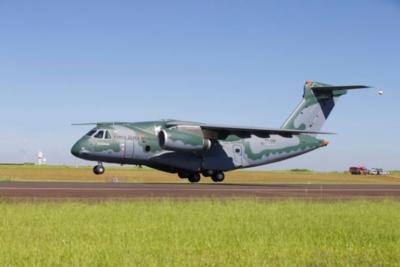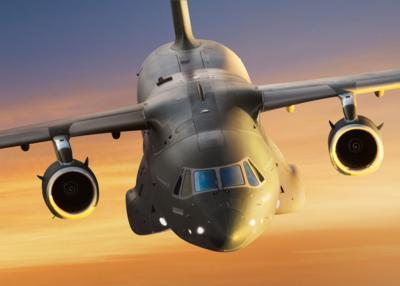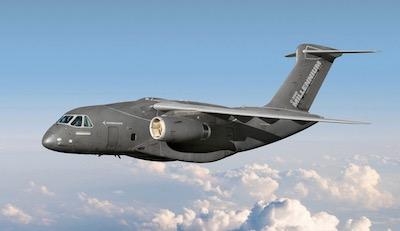The Smallest Large Cargo Aircraft
Embraer S.A., announced that it had debuted the first Full-Flight Simulator (FFS) germane to its C-390 Millennium—the plane-maker’s medium-size, twin-jet, military transport aircraft.

The inauguration ceremony was held at the company’s Embraer Academy facility and attended by representatives of the Brazilian and Portuguese Air Forces, and representatives from German automotive and arms manufacturer Rheinmetall.
Embraer Services & Support president and CEO Johann Bordais stated: “The new KC-390 flight simulator will meet the demands of current and future customers for basic and advanced pilot training, thus contributing to the safe and effective operation of the aircraft. Brazil, Portugal, and Hungary will be the first countries to use this equipment, which allows the safe practice of maneuvers and emergency procedures, as well as other adverse flight conditions, with reduced costs and without risks to the operation.”
Rheinmetall Aviation Services CEO and head of Dimension Air Mike Schmidt remarked: “Rheinmetall is proud to have been selected as the preferred partner of Embraer for the KC-390 transport aircraft training devices. This KC-390 flight simulator will be the first of many training devices to support the safe and effective education and training of future KC-390 transport aircraft operators worldwide.”
The level-D KC-390 flight simulator includes operation under normal and emergency conditions, a package to support military operations, and more than 350 failure simulations. Moreover, the simulator is easy to maintain and comfortable for pilots and instructors alike.
Embraer’s C-390 Millennium is a mid-sized utility transport aircraft of a conventional high-wing, twin-jet-engine, T-tail empennage design. The aircraft evokes images of a growth-hormone deficient Boeing C-17 Globemaster III deprived of half its engines and kitted-out with an over-cockpit refueling-probe similar to that of Airbus’s A400M turboprop transport.
The C-390 is powered by a pair of 31,330-lbf. IAE V2500-E5 turbofan engines mounted forward of the aircraft’s high wing. So motivated, the aircraft manages a 533-knot (0.799 Mach) maximum speed, a 470-knot (0.70 Mach) cruise speed, and an unremarkable service-ceiling of FL360. The C-390’s 191,800-pound maximum takeoff weight comprises a 77,161-pound empty weight, a 57,320-pound payload, and a standard fuel capacity of 50,700-pounds.

Founded in 1983 for the express purpose of developing a turbine engine conducive to the needs of the 150-seat single-aisle aircraft market, International Aero Engines (IAE) is a Zürich-registered joint venture of Pratt & Whitney, Germany’s MTU Aero Engines AG, and the Japanese Aero Engine Corporation. The company’s V2500 turbofan engine is among the world’s most popular aircraft powerplants and can be found slung beneath the wings of Airbus’s A320 family.
To the subject of wings, Embraer provisioned the C-390 with an elegant and efficient high-main-wing featuring a conspicuous anhedral angle, slats, and high-lift devices capable of deploying to 40-degrees deflection. The design affords the C-390 a degree of agility rare in cargo aircraft and occasions excellent low-speed manners—to include a leisurely 104-knot Vso stall-speed.
The two, dual-axle main assemblies of the C-390’s undercarriage retract into bilateral sponsons affixed to the lower, underwing aspect of the aircraft’s fuselage. The single-axle nose-wheel is steerable via a flight-deck tiller. Tires are of the low-pressure (85-psi) variety. Collectively, the architecture facilitates operations from soft, unpaved ground, austere airstrips, and damaged runways.
The C-390’s two-pilot crew interface with the aircraft via dual active sidesticks commanding a fully fly-by-wire flight-control system. Power-management is by dint of a Full Authority Digital Engine Control (FADEC) scheme and autothrottles.
The C-390’s flight deck is handsomely appointed with Rockwell Collins’s Pro Line Fusion avionics suite, twin head-up displays, and enhanced vision. The aircraft’s Thales Group-supplied navigational system includes INS, GPS, and TCAS. The jet’s SELEX Galileo Gabbiano tactical radar is capable of Ground Moving-Target Indication (GMTI), Synthetic Aperture Radar (SAR), Inverse Synthetic Aperture Radar (ISAR), and Search And Rescue Radar Transponder (SART) modes.
By way of self-defense, the C-390 sports an Elbit Systems-supplied directional infrared countermeasures suite.

The C-390’s hold measures 61-feet in length, 11-feet-four-inches in width, nine-feet-eight-inches in height, and is accessed primarily via a large rear-ramp integrated with the aircraft’s aft-lower fuselage. The aircraft can be configured to perform missions the likes of troop, VIP, and cargo transportation, and aerial refueling (as a tanker). Fully-loaded, the C-390 can carry payloads such as two fully-tracked M113 armored personnel carriers, one Boxer armored vehicle, a Sikorsky H-60 helicopter, 74 litters with corresponding life-support equipment, up to eighty soldiers or 66 paratroopers in full gear. Loads of up to 42,000-pounds can be air dropped from the aircraft’s rear-door.
Since entering operation with the Brazilian Air Force in 2019, the C-390 has proven capable and reliable. The service’s current fleet of five aircraft—all in the KC-390 aerial refueling configuration—has accumulated north of 8,900-flight-hours with a mission-readiness rate of approximately eighty-percent and a mission-completion rate exceeding 99-percent.
To date, Embraer’s C-390 order-book contains commitments from Portugal, Hungary, and the Netherlands.
 Unfortunate... ANN/SportPlane Resource Guide Adds To Cautionary Advisories
Unfortunate... ANN/SportPlane Resource Guide Adds To Cautionary Advisories ANN FAQ: Turn On Post Notifications
ANN FAQ: Turn On Post Notifications ANN's Daily Aero-Term (04.29.24): Visual Approach Slope Indicator (VASI)
ANN's Daily Aero-Term (04.29.24): Visual Approach Slope Indicator (VASI) ANN's Daily Aero-Term (04.28.24): Airport Marking Aids
ANN's Daily Aero-Term (04.28.24): Airport Marking Aids ANN's Daily Aero-Linx (04.28.24)
ANN's Daily Aero-Linx (04.28.24)





